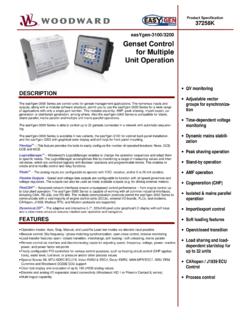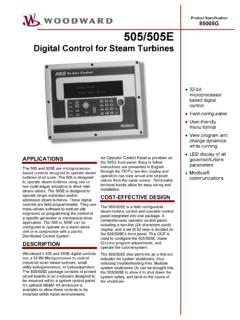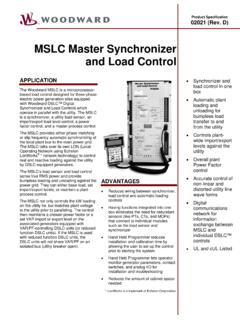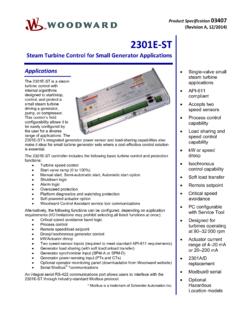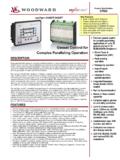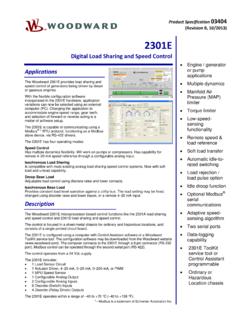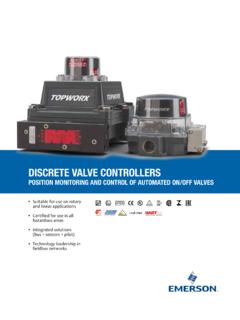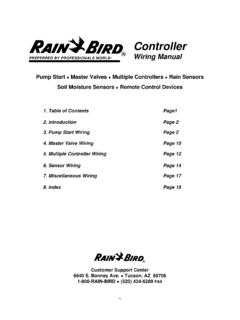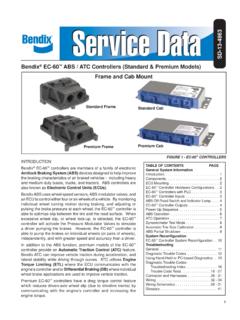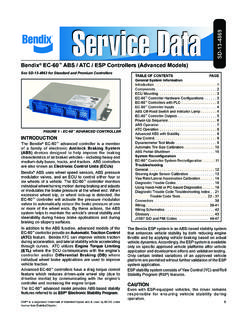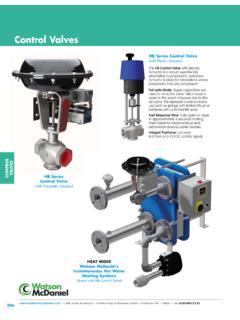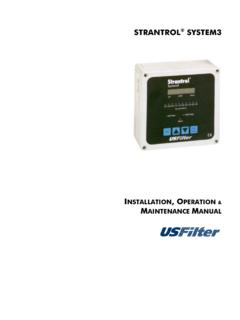Transcription of WOODWARD E3 SERIES - MSHS Group
1 WOODWARD E3 SERIES Control Systems for Rich and Lean Burn Gas Engines WOODWARD s E3 system is a fully integrated engine control solution that can be used as a stand-alone air/fuel ratio controller or as a complete gas engine emissions and engine control. The control systems comprise the E3 product line of all-encompassing engine and emissions controls designed to meet the performance and reliability needs of gas engine manufacturers, owners, and operators. The E3 system is scalable to virtually any gas engine regardless of size or power output and is available for multiple applications including: Rich Burn or Stoichiometric engines using catalytic converters Lean Burn engines running exclusively on natural gas Lean Burn engines running exclusively on low BTU fuels such as landfill, digester, or biogas Lean Burn engines running on a blend of natural gas and low BTU fuel E3 Controller The E3 controller is packaged in a NEMA-4 enclosure complete with an internal service port, and is pre-wired to a terminal strip for simple interface to the field wiring.
2 Some versions of the system are available with an enclosure door mounted HMI for display of engine and system parameters such as speed, load, coolant temperature, manifold pressure and temperature, fuel valve and throttle position, along with full alarm annunciation. Fuel Valves The control system is paired with WOODWARD s world-class line of valves with integrated digital electric actuators. These butterfly-style valves are used to control the fuel supply to the engine as well as the speed governing. WOODWARD s E3 is set apart due to its integrated speed control algorithms that can be used to remove existing speed controllers in order to consolidate control functionalities into one integrated system.
3 Ignition Controls The E3 system includes integrated ignition control for smaller engines in the appropriate BMEP range. The ignition control is built into the E3 controller which fires WOODWARD s heavy-duty Smart Coils for each cylinder. This integrates engine governing, air-fuel ratio, and ignition control into one single controller -- eliminating the need for a separate ignition control box on or near the engine. Engine Sensors All necessary sensors are listed as a kit and are available for specific engine types. Depending on the application, a kit will typically consist of sensors for engine speed, manifold air pressure and temperature, engine coolant temperature, applicable oxygen sensors, and all required mating connectors. Accessories are also available such as communication adapters for the controls and actuators, mating connectors, and pre-fabricated wiring harnesses.
4 The E3 family of controls is approved by the CSA for use in areas requiring Class I, Division 2, Group A, B, C, & D certification. A L L E N C O M P A S S I N G E N G I N E & E M I S S I O N S C O N T R O L E3 Control for Lean Burn Engines Lean Burn Trim System The E3 Lean Burn Trim controller is primarily designed for use on lean burn, carbureted, natural gas-fueled engines. This system can also be used in some applications where low BTU fueled engines are operated such as landfills and digesters. This version of the system utilizes a butterfly valve placed in the fuel inlet to the engine just before the carburetor. For engines with dual carburetors, such as the Caterpillar G3500 SERIES , two valves are used. The system is referred to as a trim system since the carburetor is setting the base air/fuel ratio and the butterfly valve is trimming or fine-tuning the fuel to the engine as commanded by the E3 control.
5 System Overview Lean Burn Trim Application Full Authority System While the Lean Burn Trim system can be utilized in some select applications running low BTU fueled engines, the E3 Full Authority controller is designed specifically for this purpose. These applications include landfill, digester, or bio-fuel. The Full Authority system enables the engine to be much more responsive to variations in fuel quality. This is accomplished by replacing the simple butterfly valve used in the trim system with a true mass-flow metering valve with on-board fuel temperature and pressure sensors. This valve allows the control to deliver precisely the right amount of fuel to the engine at any given time, which is extremely important during engine start-up and when running under a certain load threshold.
6 The control is able to compensate for changes in gas quality up to 10% CH4. With the addition of a CH4 signal input to the E3 from an external gas quality analyzer, the control can compensate for changes between 20-100% CH4. System Overview Full Authority Application Patented Closed-Loop Operation for Generator Applications In a generator application, the E3 control System can be operated in two different closed-loop modes: UEGO Closed Loop or Gas Quality Closed Loop (GQCL). UEGO Closed Loop utilizes an oxygen sensor in full-time operation and is part of the base system. This mode of operation is comparable to what is used in air/fuel ratio controllers from other manufacturers on the market. The drawback to this is the requirement for an oxygen sensor installed in the engine exhaust to be used in the system at all times.
7 Since standard oxygen sensors on the market are designed for automotive-style gasoline engines, not natural gas engines, the lifetime of standard sensors in operation on industrial gas engines is typically an issue. Gas Quality Closed Loop (GQCL) control (patents: US5657732 / EP0727574B1) uses engine efficiency and generator load measurement to eliminate the oxygen sensors. The E3 control calculates the amount of fuel required for a given emissions output and then commands the fuel control valve to deliver the optimum amount of fuel to the engine. In this manner, only the precise amount of fuel is delivered in order to achieve the highest fuel economy without putting the engine into detonation or misfiring conditions. GQCL operation is based on algorithms that are exclusive to WOODWARD , resulting in a system that is set apart from the competition offering increased performance for a comparable price.
8 The only addition required is a kW load feedback signal into the E3 control. This can come from an existing load transducer or one can be added. E3 Control for Rich Burn Engines The E3 Rich Burn control system is designed for use on stoichiometric, natural gas-fueled engines. The control system provides highly stable, closed-loop control of air/fuel ratio on engines using three-way catalysts and features WOODWARD s exclusive StableSense technology. The system is configurable for use on inline or V-engines with either a single fuel supply or a dual fuel supply with a separate manifold for each bank. For engines with a single fuel supply, a pre-catalyst and post-catalyst oxygen sensor is used. For engines with an independent fuel supply for each bank, an additional pre-catalyst oxygen sensor is added to the second bank and the control utilizes automatic bank balancing for improved engine performance.
9 In addition, the system can be expanded by adding pre and post catalyst temperature and pressure sensors for active catalyst monitoring. System Overview Rich Burn Application Exclusive StableSense Technology The E3 Rich Burn system features StableSense technology utilizing WOODWARD s patented oxygen sensors. While other systems in the marketplace utilize standard automotive oxygen sensors that were designed for gasoline engines, WOODWARD has developed and patented an oxygen sensor specifically for industrial gas engines. These sensors are more rugged and, since they are purpose-built for gas engines, not gasoline engines, they offer an operating life that is unparalleled by standard automotive sensors in industrial applications as they are unaffected by engine exhaust methane and hydrogen.
10 The E3 StableSense control algorithms paired with the sensors are able to provide automatic control over the engine s air/fuel ratio and optimize the amount of time the engine remains in compliance. Integrated Speed Control & Governing All versions of the E3 control system offer an important feature that differentiates it from the competition. The system includes an integrated digital speed controller that can replace an existing mechanical governor or older analog electronic speed control. This option allows the speed control to be integrated with the air/fuel ratio control in the same unit which improves emissions control and engine stability since these two fundamental functions are designed to work together. Choosing the speed control option also brings the benefits of digital speed control including ease of setup and tuning with real-time graphical trending, more configuration options including multiple dynamics for different operational conditions, and improved control response.
